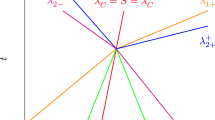Abstract
A modified form of BGK source terms is proposed for modeling two-phase flows with thermodynamical disequilibrium. The novelty is that three independent time-scales allow to manage the return to the thermodynamical equilibrium while remaining in agreement with the second law of thermodynamics. This is achieved thanks to the definition of a “local-in-time” equilibrium state which tends toward the asymptotic equilibrium state when time increases. The thermodynamical paths of the system are then modified with respect to the classical BGK source terms used for two-phase flow modeling, and the relaxation process of the system toward the asymptotic equilibrium state can be defined with additional degrees of freedom. In a numerical point of view, both the classical and the modified BGK source terms have advantages. The choice between these two forms strongly depends on the numerical strategy used to perform simulations.
Similar content being viewed by others
References
Baer, M., Nunziato, J.: A two-phase mixture theory for the deflagration-to-detonation transition (DDT) in reactive granular materials. J. Multiph. Flows 12, 861–889 (1986)
Barberon, T., Helluy, P.: Finite volume simulation of cavitating flows. Comput. Fluids 34(7), 832–858 (2005)
Boukili, H., Hérard, J.M.: Relaxation and simulation of a barotropic three-phase flow model. ESAIM: Math. Model. Numer. Anal. 53(3), 1031–1059 (2019)
Boukili, H., Hérard, J.M.: Simulation and preliminary validation of a three-phase flow model with energy. Comput. Fluids 221, 104868 (2021)
Chiapolino, A., Boivin, P., Saurel, R.: A simple and fast phase transition relaxation solver for compressible multicomponent two-phase flows. Comput. Fluids 150, 31–45 (2017)
Coquel, F., Gallouët, T., Hérard, J.M., Seguin, N.: Closure laws for a two-fluid two-pressure model. C. R. Math. 334(10), 927–932 (2002)
Downar-Zapolski, P., Bilicki, Z., Bolle, L., Franco, J.: The non-equilibrium relaxation model for one-dimensional flashing liquid flow. Int. J. Multiph. Flow 22(3), 473–483 (1996)
Faccanoni, G., Kokh, S., Allaire, G.: Modelling and simulation of liquid–vapor phase transition in compressible flows based on thermodynamical equilibrium. ESAIM Math. Model. Numer. Anal. 46(5), 1029–1054 (2012)
Faccanoni, G., Mathis, H.: Admissible equations of state for immiscible and miscible mixtures. ESAIM Proc. Surv. 66, 1–21 (2019)
Faucher, E., Hérard, J.M., Barret, M., Toulemonde, C.: Computation of flashing flows in variable cross-section ducts. Int. J. Comput. Fluid Dyn. 13(3), 365–391 (2000)
Gavrilyuk, S., Saurel, R.: Mathematical and numerical modeling of two-phase compressible flows with micro-inertia. J. Comput. Phys. 175(1), 326–360 (2002)
Ghazi, H.: Modélisation d’écoulements compressibles avec transition de phase et prise en compte des états métastables. Ph.D. thesis, Université de Nantes (2018). https://tel.archives-ouvertes.fr/tel-01379453
Ghazi, H., James, F., Mathis, H.: Vapour–liquid phase transition and metastability. ESAIM Proc. Surv. 66, 22–41 (2019)
Ghazi, H., James, F., Mathis, H.: A nonisothermal thermodynamical model of liquid–vapor interaction with metastability. Discrete Contin. Dyn. Syst. B 26(5), 2371–2409 (2021)
Glimm, J., Saltz, D., Sharp, D.: Two-pressure two-phase flow. In: Advances in nonlinear partial differential equations and related areas: a volume in Honor of Professor Xiaqi Ding, pp. 124–148. World Scientific (1998)
Hantke, M., Müller, S., Grabowsky, L.: News on Baer–Nunziato-type model at pressure equilibrium. Contin. Mech. Thermodyn. 33(3), 767–788 (2021)
Helluy, P., Hurisse, O., Quibel, L.: Assessment of numerical schemes for complex two-phase flows with real equations of state. Comput. Fluids 196, 104347 (2020)
Hérard, J.M., Hurisse, O.: A fractional step method to compute a class of compressible gas–liquid flows. Comput. Fluids 55, 57–69 (2012)
Hurisse, O.: Numerical simulations of steady and unsteady two-phase flows using a homogeneous model. Comput. Fluids 152, 88–103 (2017)
Hurisse, O.: Various choices of source terms for a class of two-fluid two-velocity models. ESAIM Math. Model. Numer. Anal. 55(2), 357–380 (2020)
Hurisse, O., Quibel, L.: A homogeneous model for compressible three-phase flows involving heat and mass transfer. ESAIM Proc. Surv. 66, 81–108 (2019)
Hurisse, O., Quibel, L.: Simulations of liquid–vapor water flows with non-condensable gases on the basis of a two-fluid model. Appl. Math. Model. 99, 514–537 (2021)
Jin, H., Glimm, J., Sharp, D.: Compressible two-pressure two-phase flow models. Phys. Lett. A 353(6), 469–474 (2006)
Jung, J.: Numerical simulations of two-fluid flow on multicores accelerator. Ph.D. thesis, Université de Strasbourg (2013). https://tel.archives-ouvertes.fr/tel-00876159
Kapila, A.K., Menikoff, R., Bdzil, J.B., Son, S.F., Stewart, D.S.: Two-phase modeling of deflagration-to-detonation transition in granular materials: reduced equations. Phys. Fluids 13(10), 3002–3024 (2001)
Liu, Y.: Contribution to the verification and the validation of an unsteady two-phase flow model. Ph.D. thesis, Aix-Marseille Université (2013). https://tel.archives-ouvertes.fr/tel-00864567
Lochon, H.: Modélisation et simulation d’écoulements transitoires eau-vapeur en approche bifluide. Ph.D. thesis, Aix Marseille Université (2016). https://tel.archives-ouvertes.fr/tel-01379453/document
Mathis, H.: A thermodynamically consistent model of a liquid–vapor fluid with a gas. ESAIM Math. Model. Numer. Anal. 53(1), 63–84 (2019)
Müller, S., Hantke, M., Richter, P.: Closure conditions for non-equilibrium multi-component models. Contin. Mech. Thermodyn. 28(4), 1157–1189 (2016)
Quibel, L.: Simulation of water-vapor two-phase flows with non-condensable gas. Ph.D. thesis, Université de Strasbourg (2020). https://tel.archives-ouvertes.fr/tel-02941486
Stewart, B., Wendroff, B.: Two-phase flows: models and methods. J. Comput. Phys. 56(7), 363–409 (1984)
Author information
Authors and Affiliations
Corresponding author
Additional information
Communicated by Andreas Öchsner.
Publisher's Note
Springer Nature remains neutral with regard to jurisdictional claims in published maps and institutional affiliations.
Appendix: computation of the formulas of section 4.4
Appendix: computation of the formulas of section 4.4
We present here the detailed computations that allow to retrieve equations (35) and (36). It is first recalled that perfect gas EOS are considered in Sect. 4.4; hence, we have: \(P_k/T_k=\delta _k/\tau _k\), with \(\delta _k=(\gamma _k-1) C_{V,k}\) and \(1/T_k=C_{V,k}/e_k\). Moreover, mass fractions are assumed to be such that: \(y_1=\overline{y}_1\), so that definitions (34) lead to:
Thanks to the definitions of the mixture pressure and temperature (6) and to the definitions (4), we have:
Hence, we obtain the formula of Eq. (35). Equation (36) can be found using exactly the same computations with \((\overline{z}_1-z_1)\).
Rights and permissions
About this article
Cite this article
Hurisse, O. BGK source terms for out-of-equilibrium two-phase flow models. Continuum Mech. Thermodyn. 34, 721–737 (2022). https://doi.org/10.1007/s00161-022-01085-9
Received:
Accepted:
Published:
Issue Date:
DOI: https://doi.org/10.1007/s00161-022-01085-9




